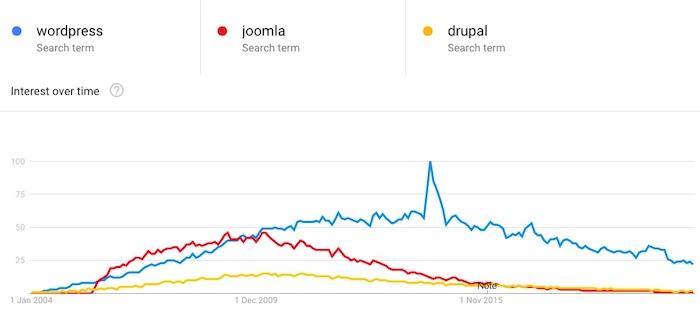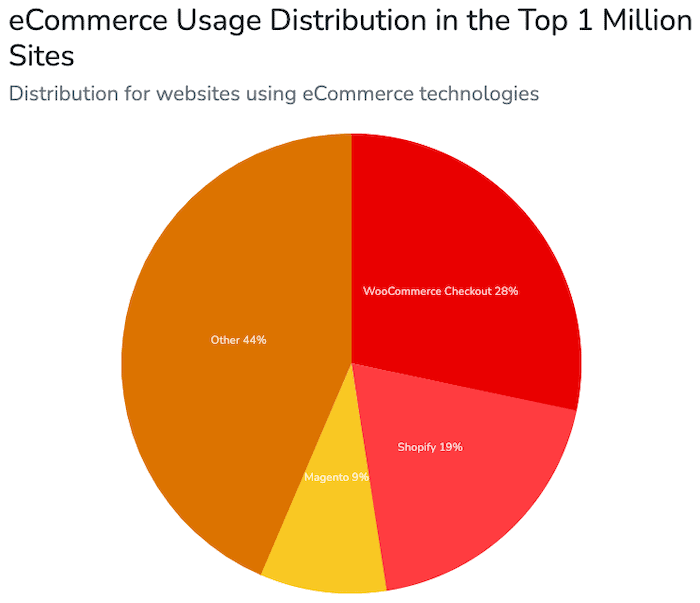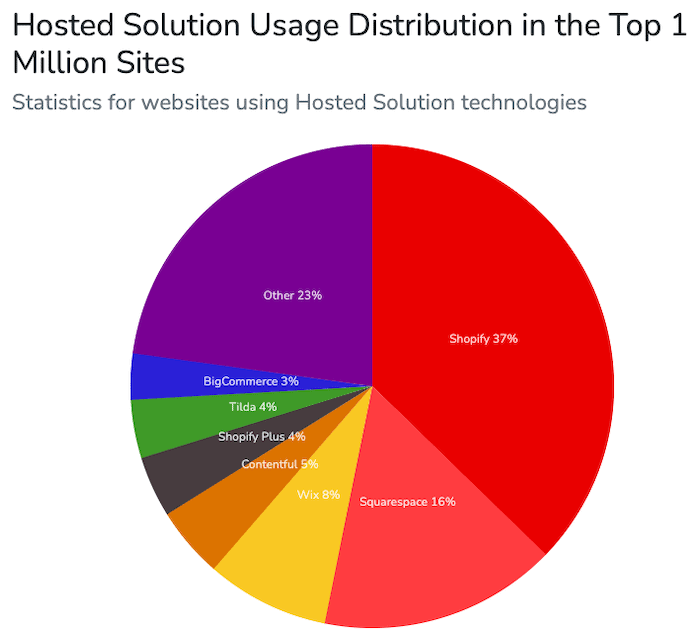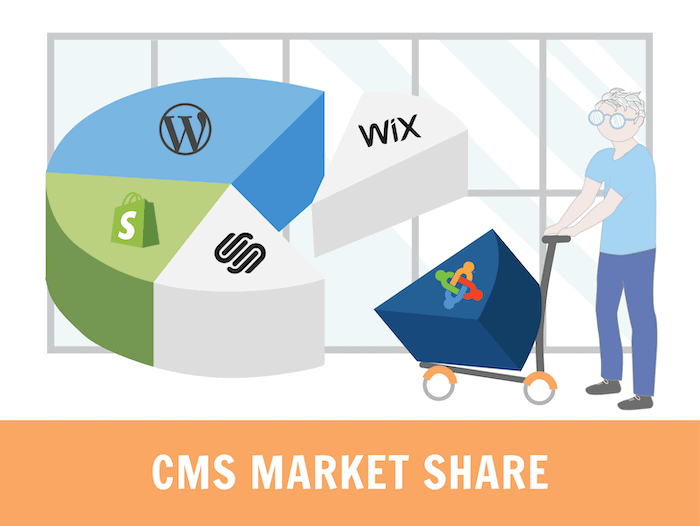Content management systems (CMS) have exploded in popularity over the last ten years. In 2011, a whopping 76% of websites were hand-coded. Now, with the availability of CMSs like WordPress, Shopify, and Wix, that percentage has dropped to 36%.
Why are CMSs such a popular choice? Primarily because they’re relatively easy to use: you can have a website up and running with little to no coding at all. Additionally, a CMS makes it easier to update, maintain, and add advanced functionality to your website through the use of templates and plugins. With some CMSs, you don’t even have to know any HTML.
It’s no wonder they are so popular. So which CMSs are the biggest players in the market? Let’s take a look.
WordPress: The undisputed market leader
The CMS market is dominated by one big player – and it’s probably no surprise who. According to W3Techs, WordPress’s share of the CMS market has grown from 51% to 65% in just ten years. It also powers 43.2% of all websites, and 34.68% of the top 1 million websites on the web.
Market share of top 10 CMSs between 2010-2022 (W3Techs)
| CMS | 2010 Jan | 2011 Jan | 2012 Jan | 2013 Jan | 2014 Jan | 2015 Jan | 2016 Jan | 2017 Jan | 2018 Jan | 2019 Jan | 2020 Jan | 2021 Jan | 2022 Jan |
|---|---|---|---|---|---|---|---|---|---|---|---|---|---|
| WordPress | 51.0% | 55.3% | 54.3% | 54.8% | 59.8% | 60.7% | 58.8% | 58.5% | 60.0% | 59.7% | 62.1% | 64.1% | 65.2% |
| Shopify | 0.3% | 0.7% | 1.0% | 1.3% | 1.8% | 2.6% | 3.4% | 5.2% | 6.6% | ||||
| Joomla | 12.0% | 10.9% | 9.5% | 8.7% | 9.3% | 8.6% | 7.5% | 7.2% | 6.5% | 5.4% | 4.6% | 3.6% | 2.6% |
| Squarespace | 0.2% | 0.2% | 0.1% | 0.3% | 0.5% | 0.8% | 1.1% | 1.5% | 2.6% | 2.7% | 2.3% | 2.7% | |
| Wix | <0.1% | 0.2% | 0.3% | 0.4% | 0.6% | 0.9% | 1.8% | 2.3% | 2.4% | 2.9% | |||
| Drupal | 7.1% | 6.1% | 6.5% | 7.2% | 5.5% | 5.1% | 4.9% | 4.8% | 4.6% | 3.5% | 3.0% | 2.5% | 2.0% |
| Bitrix | 0.8% | 0.9% | 1.0% | 1.0% | 1.1% | 1.3% | 1.4% | 1.5% | 1.2% | 1.5% | 1.7% | 1.4% | |
| Blogger | 2.7% | 3.0% | 3.5% | 3.3% | 2.9% | 2.7% | 2.4% | 1.9% | 1.4% | 1.5% | 1.6% | 1.5% | |
| Magento | 2.7% | 2.8% | 2.9% | 2.7% | 2.4% | 1.9% | 1.5% | 1.2% | 1.1% | ||||
| OpenCart | 0.9% | 1.0% | 0.9% | 0.8% | 0.8% | 0.8% | 1.0% | 0.8% |
A few other open-source CMSs have entered the market, but WordPress remains the most popular because it’s powerful, affordable, and versatile – its huge library of themes and plugins give it a lot of flexibility. It has a built-in blogging platform and provides support for most languages. It is also especially strong in SEO. Additionally, you have the rights to your own content and can download it at any time. Plus, you can host your site wherever you want.
WordPress is used for all kinds of websites from big, well-established brands like Microsoft.com and Etsy.com, to blogs such as TechCrunch and Ted Blog. (We even run our own website on it!)
WordPress isn’t the only open-source CMS in the market. Its biggest contender, Joomla, is also open source but hasn’t seen the same growth as WordPress. Its market share has been declining over the past few years and it currently holds only 2.6% of the CMS market share. Joomla started out as a platform for big websites, but has failed to evolve in the way WordPress has, with the platform widely being viewed as outdated and slow. Its smaller plugin library is another reason why people tend to opt for WordPress.
Another open-source CMS is Drupal which holds around 2% of the CMS market share. Drupal (created in 2001) has actually been around a few years longer than WordPress (launched in 2003). Offering more advanced access controls and taxonomies, it is most useful for websites with a lot of content and users. However, it has a steeper learning curve than WordPress and generally requires more customization.
This trend is also reflected in Google search interest. Taking a look at Google Trends, we can see that there was once more interest in Joomla than in the other platforms. Since 2009 however, WordPress has become the most searched-for CMS, while interest in Joomla and Drupal has dropped off significantly.

WooCommerce and Shopify dominate eCommerce
Although it’s the CMS with the second largest market share, Shopify still trails far behind WordPress significantly with only 5.5% of the market.
According to Builtwith, it also comes second to WooCommerce, another ecommerce solution, in the list of top 1 million sites.

You might wonder why WooCommerce isn’t showing up on this list. That’s because it’s a plugin for WordPress rather than a standalone CMS. It’s another reason why WordPress is popular even among the ecommerce market — 19.6% of all WordPress sites use the WooCommerce plugin.
WooCommerce’s popularity may come from the fact that it’s available on an open-source platform like WordPress, which means there are limitless options for customization. It’s also a better option for cost-conscious shop owners but requires coding experience to really take full advantage of its features.
While its market share isn’t as large as WooCommerce, Shopify’s share isn’t insignificant. It still has a much larger share than other ecommerce CMSs like Magento, OpenCart and Prestashop.
Shopify had a strong year of growth between 2020 and 2021. This is likely due to the increase in online shopping during the pandemic, as store owners moved their shops online and more consumers shopped online during lockdown.
Wix and Squarespace: Battling it out for biggest website builder
As we can see in W3Tech’s findings, the two biggest contenders in the website builder space are Wix and Squarespace. Squarespace has been around for a couple of years more than Wix and has been slowly growing, although Wix has caught up and both hold over two percent of the CMS market share.
Both platforms are constantly improving their templates and adding new features, with Wix expanding into new product areas like Ascend by Wix, Wix Velo, and Wix ADI. Squarespace instead has focused more on acquiring outside tools: Acuity Scheduling (a scheduling solution similar to Calendly) as well Tock, an online reservations platform for the hospitality industry.
If we take a look at the top 1 million sites however, the numbers paint a different picture. Shopify still dominates the top website market (37%), with Squarespace holding a much higher usage rate (16%) compared to Wix (8%).

According to the stats, bigger websites with higher levels of traffic are much more likely to use Squarespace than Wix. Our own tests found that Wix sites had some of the slowest page loading speeds, so this wasn’t a huge surprise to us.
There are other comparable website builders, such as Weebly, Webflow and GoDaddy that have a much smaller share of the market according to W3Techs, although they do also appear to be growing slightly over the years.

Feature-wise they aren’t as rich as Wix and Squarespace (and in Webflow’s case, the tool is more complex) so that could account for why they aren’t as popular.
CMS vs website builder: What’s the difference?
It’s clear that open-source CMSs and web builders are gaining in popularity – but what’s the difference between them? They have a lot of similarities which cause confusion for many folks. For instance, both allow you to create a website without coding or specialized knowledge.
The main difference is that for CMSs – and specifically, open-source CMSs like WordPress – you get more control over the design and features of your website as you have full access to the source code. While there are a lot of ready-made plugins and themes available to choose from, you can tweak them if you are proficient in HTML and CSS. You also get to choose where to host your site, although a lot of CMS platforms have options to host your site there. If you decide to move to a different host, you can download your site then move to your new server.
With this flexibility and control come some challenges: you are in charge of maintaining and hosting your site. However, there are plenty of cheap web hosts to choose from. And fortunately, many CMS hosting platforms will notify you of updates.
A website builder is a type of CMS that lets you create a website through the builder’s hosting platform – for example, Wix, Squarespace or Shopify. They’re generally easier to use than CMSs, letting you build your site through drag-and-drop builders and visual editors. Hosting, maintenance and security are also all taken care of by the provider. And usually there are even free plans to chose from.
The main downside is that you (usually) can’t download and move your site to another host. The website builder’s tools and code are proprietary, and once you’ve started your site on a builder platform, you generally won’t be able to export it, although there are some exceptions.
If you’d like a more zoomed-in view of what the website builder market share looks like, check out our article here.
Notable mentions: Bitrix and Blogger
It’s also worth mentioning Bitrix and Blogger, which make #7 and 8 on the list. Bitrix offer a wide range of digital business solutions, one of which is their website builder. Although they may not be a widely-known CMS, market share is going up for them; their website states that they have over 9 million organizations in their customer base.
Google-owned Blogger on the other hand seems to be declining in market share. In fact, taking a look at Google Trends, you can see that interest in Blogger peaked in early 2010 – since then, it’s been steadily dropping off.

Interest in Blogger over time, according to Google Trends
Compared to other website builders it’s very limited in functionality, which could be the reason why it hasn’t been as popular. It’s great for very basic blogging, but you have less control over your platform. Google can discontinue your account at any point and there’s no option to download and host your content elsewhere.
The future of the CMS market
CMSs are expected to increase in popularity as more businesses, entrepreneurs, content creators and consumers get online and build more complex websites—in fact, they are estimated to generate $123 billion by 2026. According to Zion Market Research, CMSs will continue to overtake custom-built websites, which require a lot more time, expertise, and expense to develop and maintain.
This will be seen primarily among small-to-medium enterprises, with the US and Europe driving most of this growth (and within Europe, the UK and Germany in particular). Asia Pacific will also be a major driver of growth in the future. The industries that are expected to increase usage of CMSs are mostly IT, telecommunication, healthcare, and life sciences.
Conclusion
The usage of CMS and website builders has always been trending upward, but Covid-19 pandemic has sped up this growth. As more and more content creators, freelancers and small-to-medium enterprises transition online, many of them desire a faster and more cost-effective solution than coding a website from scratch. This is why CMSs and website builders are so popular, and will continue to be so.
WordPress holds a staggeringly large cut of that market share due to its user-friendly interface, affordability, and flexibility due to a massive number of themes and plugins. Other platforms have also found a following, with Squarespace gaining customers among the artistic market, Wix with small businesses, and Joomla with larger enterprises. For most however, WordPress still offers the most bang for their buck.
Were you surprised about the CMSs that have the biggest market share? Tell us your thoughts!
We keep our content up to date
02 May 2022 - Updated numbers
THE BEHIND THE SCENES OF THIS BLOG
This article has been written and researched following a precise methodology.
Our methodology

